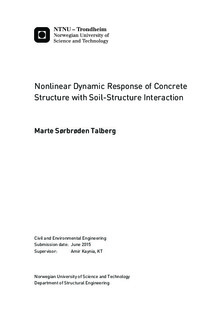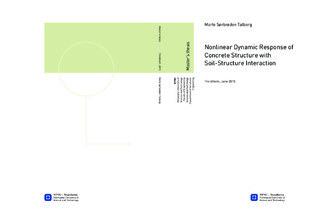| dc.description.abstract | A common assumption for a structure that is subjected to an earthquake is that the structure is considered fixed at the base. In this thesis, analyses where the soil is deformed and the foundation may be moved and rotate have been done, and it has been investigated if this can reduce forces or displacements in the structure. This have been done through the use of soil-structure interaction (SSI).
In this thesis well known beam-column element formulations will be presented, and the benefits and disadvantages will be briefly explained. Formulations for elements that are force-based and displacement-based with distributed plasticity are presented, as well as concentrated plasticity elements with fiber discretization. Both the physical and numerical definition of localization are explained, and regularization methods to prevent numerical localization have been discussed. A pushover analysis has been done for each of the element formulation in SeismoStruct, such that the effect of change in number of elements and spacing in stirrups could be examined. The pushover analyses were done for load in both one and two directions. At last, a 3D-model was used to see the effect of change in spacing in stirrups when excitation in two directions is applied.
The attention is then brought over to use of SSI on structures, and the effect of applying this to a structure. An explanation on how to formulate SSI problem is given, and how to apply this in SeismoStruct through the use of link elements. These elements requires that a hysteresis curve is defined for each of the six degrees of freedom, and suitable models are presented. To model the soil's behavior, two models are used; the Ramberg-Osgood model and a linear model. To see the effect of SSI, a parameter study has been done. A study on how the results are changed by use of nonlinear horizontal springs, linear rocking springs, increased acceleration, smaller foundation and both linear horizontal and rocking springs have been done in SeismoStruct, by looking at one parameter at a time. Analyses where the structure was expanded by one floor, were also done, due to the possibility of seeing the effect of SSI in several places in the structure.
Through the analyses that is done, it has been observed that by taking the soil stiffness into consideration, the forces and moments can be reduced. The best effect was shown by decreasing the size of foundation, for both one and two stories. | |

